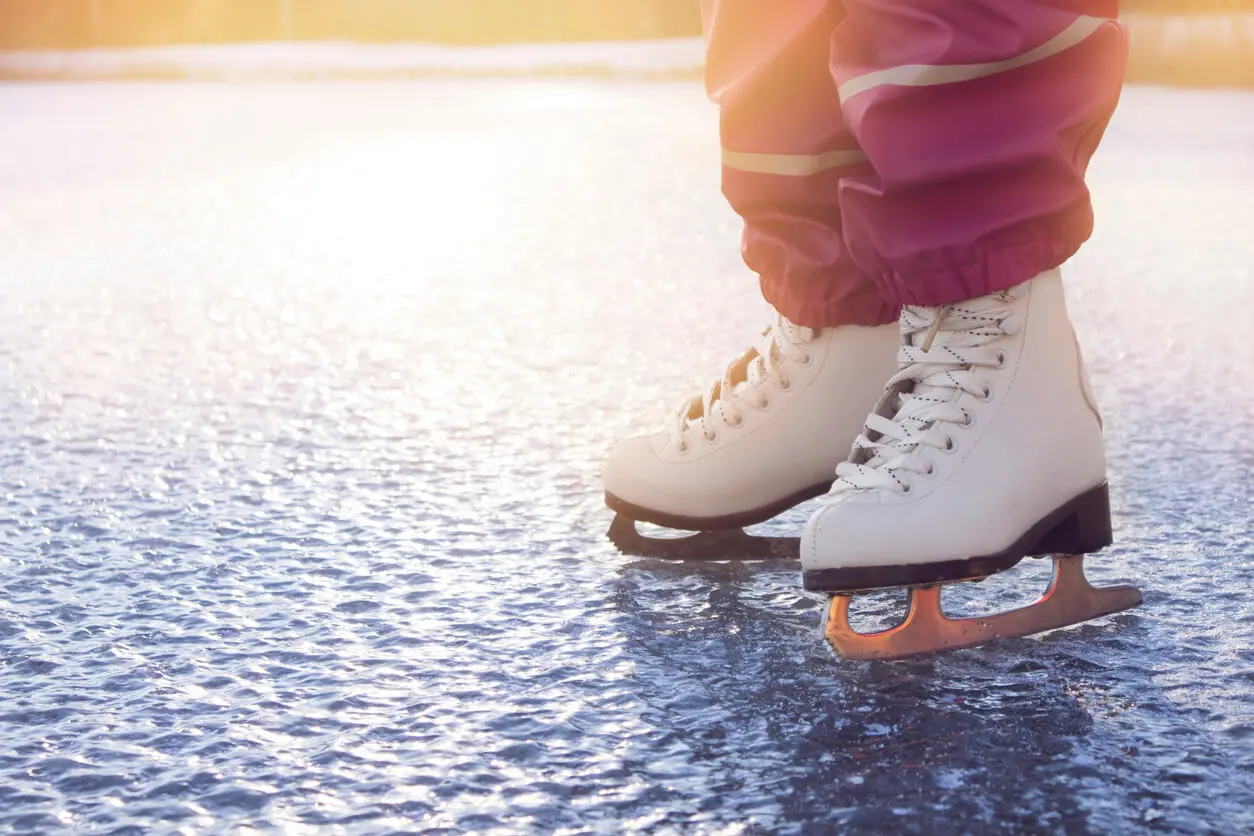This holiday season, Gluckstein Lawyers is wishing you and your loved ones a restful and restorative break. We want to remind you of the measures you should take to have a safe and fun time with your young ones when participating in winter activities including pond or rink skating.
When pond skating
The most important factors when contemplating pond or lake skating are ice colour and thickness. According to the Canadian Red Cross, the colour of the ice on a frozen body of water might be an indication of its strength. The Canadian Red Cross states: Clear blue ice is the strongest ice, white opaque or snowy ice is half as strong as blue ice, and grey ice is highly unsafe as it indicates the presence of water. [1] Remember this saying from the Weather Network: “If the ice is grey, stay away!” [2] Further, the minimum thickness of the ice should be 15 cm for walking or skating alone and 20 cm for skating games. [3] Both the Canadian Red Cross and the Weather Network caution that aside from colour and thickness, other factors to take into consideration on open ice are moving water; fluctuations in water levels; water depth/size of body of water; and changing air temperature. Play Outside Guide warns: “Rapid cooling is just as dangerous as rapid warming--warming can cause ice to melt and cooling can cause ice to crack--ice strength can change throughout the day so always check the ice before allowing others onto it.” [4]
Keeping kids safe on pond, lake, and rink ice
To prevent injuries while skating, children should always wear a helmet. Take Them Outside states: If your child is skating alone or with an adult, a bike or ski helmet will do. If they are participating in games, a hockey helmet is encouraged. [5] Ensure your child is dressed appropriately with gloves, warm socks, a hat and layers to prevent freezing. If your child is still cold outdoors, wearing ski goggles and a balaclava or buff underneath their helmet will keep their face warm; additionally, keeping mittens or hand warmers in jacket pockets is great for young kids. [6] If your child is new to skating and you are on a pond or lake, you should hold their hand and skate with them in the same direction as everyone else, close to shore. [7] Putting a PFD over your child’s coat is also encouraged. [8] According to the Government of Canada: if you are on rink ice, young children should hold the railing or a hockey stick for support while learning. Always supervise your child and keep them within arm’s reach, even if they’re old enough to skate alone. [9] The Children’s Hospital of Pittsburgh further encourages you to teach your kids how to fall properly to avoid injuries. Children should practice falling in a way that protects their limbs, and, most importantly, their heads. [10]
If you are bringing a baby or young child who isn’t quite old enough to skate, Take Them Outside notes that bringing a sled is a great activity for the whole family. Their suggested uses include:
- You can pull bundled children in a sled.
- You can put your extra clothes and snacks (or tired skaters) into a sled and pull that along if you’re going for a long-distance skate.
- Children can have fun just pulling each other and playing around with the sled on the ice. [11]
If you are in an emergency situation on a pond or lake
Follow the Canadian Red Cross’s plan for these types of emergencies:
- Call for help immediately.
- If there are no emergency professionals close enough to perform a rescue, the safest way to perform a rescue is from the shore.
- Check if you can reach the individual with a hockey stick, pole, or branch. If you can, lie down and extend the pole to the person.
- If you must go into the ice, wear a PFD and carry the stick, pole or branch to test the water in front of you. Bring an item to reach or throw to the person caught in the water. A rope with a loop tied on the end or a flotation ring is helpful if the victim is not wearing a lifejacket.
- When you get close to the broken ice, lie down to distribute your weight and crawl slowly toward the hole. Remain low and extend or throw your emergency rescue device to the person.
- Have the person kick while you pull them out. [12]
Sources
[1],[3],[9],[12] Ice safety - Canadian Red Cross. Red Cross Canada. (n.d.). [2] Sutherland, S. (2020, December 24). Is it safe? How thick does ice need to be to walk or skate on? The Weather Network. [4] Play Outside Guide. (2021, March 22). Pond and lake ice safety. Play Outside Guide. [5],[6],[8],[11] Some must read tips before bringing your kids onto that Frozen Lake! Take Them Outside (2021, November 7). [7] Health Canada. (2013, October 31). Government of Canada. Canada.ca. [10] Trinh, B. (2013, March 21). How to keep your kids safe on the ice. HuffPost.
Share
Subscribe to our Newsletter

